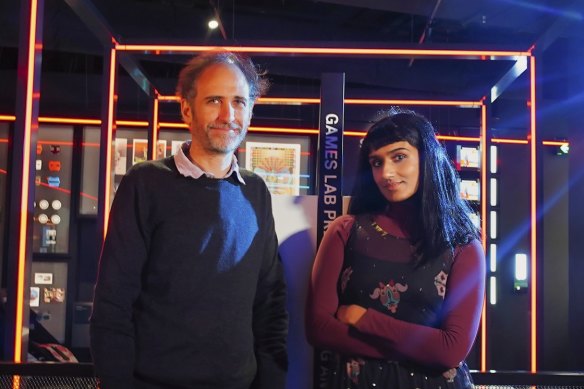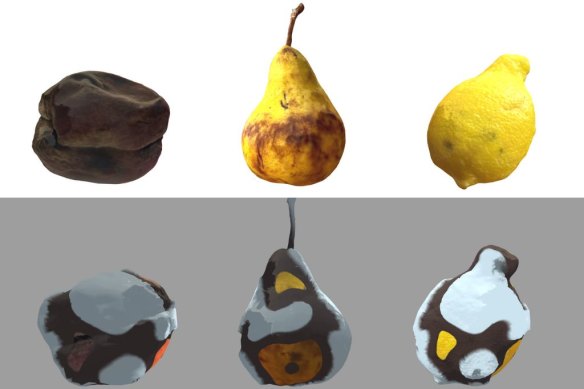This was published 9 months ago
This video game doesn’t care if you never play it again
By Nell Geraets
The fact that video games can be addictive is no secret. The compulsion to keep playing can manifest as simply as logging on once or twice a day, to the most extreme end of the spectrum, where gamers die of exhaustion after being unable to tear themselves away from the screen.
Many games are intentionally designed to keep you locked in, largely thanks to “dark pattern design”. Dark patterns, a term coined by user-interface designer Harry Brignull in 2010, essentially encourage compulsive and addictive behaviours. It’s the reason some of us find ourselves infinitely scrolling on our phones, paying to skip ads in games, or “grinding” (completing repetitive parts of a game to create the illusion of progress). These actions may feel within our control, but they’re actually carefully orchestrated by the game’s developers.

Ian MacLarty and Vidya Rajan created Rotted Luck to poke fun at the darker side of gaming.Credit: Luis Enrique Ascui
Considering the glut of entertainment available these days, it’s little surprise that most creators lean on dark pattern design to pull audiences in and keep them there. But for Vidya Rajan and Ian MacLarty, this is precisely what they wanted to avoid.
The Melbourne-based design duo created Rotted Luck, a movement-based game that pokes fun at the darker side of gaming. Commissioned by ACMI for Melbourne International Games Week, Rotted Luck asks players to act as a sentient fungus that has overtaken a slot machine. As they move around in front of a large screen, which is equipped with a webcam to track their movements, the shiny slot machine fruits go mouldy and morph into different shapes.
“It’s almost like an anti-slot machine,” MacLarty explains. “It has no numbers as rewards, there’s no score. The reward is the visual effects, the way it responds to you. But you don’t really have direct control. You can see your movements are causing it to do something, but you’re not sure what, and you can’t predict what it will do next.”
Instead of designing the game with a clear goal, such as “levelling up” or winning, Rotted Luck was designed purely to ignite curiosity and physical experimentation in its players.

Stills from the non-addictive Rotted Luck video game.Credit: Vidya Rajan and Ian MacLarty
“I don’t mind if someone plays it once and doesn’t ever come back to it,” MacLarty says. “You also don’t need to start at the beginning. You can walk in halfway and still be able to engage with it.”
You can also play with others, Rajan notes, making it a communal game that feels less isolating and therefore generally less addictive. “You may just want to watch others play it, so you don’t even have to play it yourself.”
Compared with most games, which usually require a certain degree of skill, isolation and time commitment, this sounds rather freeing. But Rotted Luck is still a video game, and video games need to be played. So, how can it keep people engaged and satisfied without using any dark pattern design?
“There’s a silliness to the game. Silliness always draws people in,” Rajan says. “There’s also a sense of mystery – like what’s going to change next – and even something slightly sinister in a fun way. There’s curiosity and constant surprise. All of that combines to create an interesting and non-addictive experience.”
Its accessibility is also a key appeal, MacLarty adds. “Controllers, keyboards and a mouse can seem a bit intimidating. But with this, you just walk in front of it, and it starts reacting to you … it’s really immediate and accessible.”
Ultimately, Rajan says Rotted Luck “doesn’t want anything from you”. There are no unskippable ads, no competition between players, no clear rewards, and the difficulty levels are not manipulated as the game progresses. Unlike many games, which often take advantage of the “sunk cost fallacy” – which makes gamers feel they’ve invested too much time and effort in a game to simply stop playing – this game instead encourages players to become aware of dark patterns, as well as their broader relationship with interactive media.
There’s something rather ironic about a video game encouraging people to become more aware of how they interact with other video games, or a video game that pokes fun at the addictive nature of video games. However, Rajan says working within the medium itself was the perfect avenue for social commentary.
“A game is not complete without the player. It’s not a passive artwork,” she says. “You play as yourself in the game’s world. There’s real agency involved, so it can have a visceral feeling of critique.”
Rotted Luck will be available to play for free at ACMI from October 5 to 13, as part of Melbourne International Games Week.
Find out the next TV, streaming series and movies to add to your must-sees. Get The Watchlist delivered every Thursday.